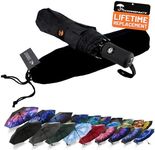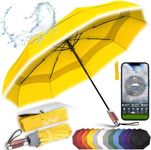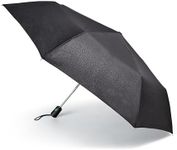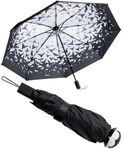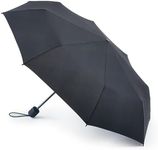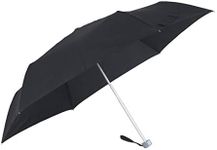Buying Guide for the Best Compact Umbrellas
Choosing the right compact umbrella can make a big difference in how well you stay dry and how convenient it is to carry around. Compact umbrellas are designed to be portable and easy to store, making them ideal for travel, commuting, or just keeping in your bag for unexpected rain. When selecting a compact umbrella, consider the following key specifications to ensure you get the best fit for your needs.Size and WeightSize and weight are crucial for a compact umbrella because they determine how easy it is to carry and store. A smaller, lighter umbrella is more portable and can easily fit in a purse or backpack, making it ideal for daily use or travel. However, smaller umbrellas may offer less coverage. If you need more protection from the rain, you might opt for a slightly larger compact umbrella that balances portability with coverage. Consider your typical usage scenarios to decide the right size and weight for you.
Canopy MaterialThe canopy material affects the umbrella's durability and water resistance. Common materials include polyester, nylon, and pongee. Polyester is durable and dries quickly, making it a popular choice. Nylon is lightweight and strong but may take longer to dry. Pongee is a high-quality fabric that offers excellent water resistance and durability. If you need an umbrella for heavy rain, look for one with a high-quality, water-resistant canopy material. For occasional use, a standard polyester canopy may suffice.
Frame ConstructionThe frame construction determines the umbrella's strength and wind resistance. Frames are typically made from materials like aluminum, steel, or fiberglass. Aluminum frames are lightweight and resistant to rust, making them easy to carry. Steel frames are stronger but heavier, providing better wind resistance. Fiberglass frames offer a good balance of strength and flexibility, making them ideal for windy conditions. Consider the typical weather conditions in your area to choose the right frame material for your needs.
Opening MechanismThe opening mechanism can affect the ease of use and convenience of the umbrella. There are manual, automatic, and semi-automatic mechanisms. Manual umbrellas require you to push the canopy open and closed, which can be more durable but less convenient. Automatic umbrellas open and close with the push of a button, offering quick and easy operation, which is great for sudden rain showers. Semi-automatic umbrellas may open automatically but require manual closing. Think about how quickly you need to deploy your umbrella and choose the mechanism that best suits your lifestyle.
Wind ResistanceWind resistance is important if you live in an area prone to strong winds. A wind-resistant umbrella is designed to withstand gusts without flipping inside out. Look for features like vented canopies, which allow wind to pass through, and reinforced frames that provide extra stability. If you often face windy conditions, investing in a wind-resistant umbrella can save you from the frustration of a broken umbrella. For areas with mild weather, standard wind resistance may be sufficient.
Handle DesignThe handle design affects the comfort and grip of the umbrella. Handles can be straight, curved, or ergonomic. Straight handles are simple and easy to store, while curved handles offer a more traditional look and can be hung on hooks or over your arm. Ergonomic handles are designed for comfort and provide a better grip, which is useful during long walks in the rain. Consider how you plan to carry your umbrella and choose a handle design that feels comfortable and practical for you.
